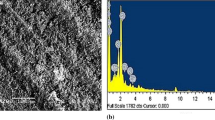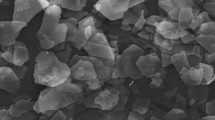Abstract
The improved performance of polymers and their composites in industrial and structural applications by the addition of particulate fillers has shown a great promise and so has lately been the subject of considerable interest. In the present study, titanium oxide (TiO2) particles of average size 75 μm are reinforced in unsaturated polyester resin to prepare particulate filled composites of three different compositions (with 0, 10, and 20 wt% of TiO2). Dry sliding wear trials are conducted following design of experiments (DOE) using a standard pin-on-disc test set-up. Significant control factors predominantly influencing the wear rate are identified. Effect of TiO2 content on the wear rate of polyester composites under different test conditions is studied. An Artificial Neural Networks (ANN) approach taking into account training and test procedure to predict the dependence of wear behavior on various control factors is implemented. This technique helps in saving time and resources for large number of experimental trials and predicts the wear response of TiO2- polyester composites beyond the experimental domain.


Similar content being viewed by others
References
Pukanszky B (1995) Particulate filled polypropylene: Structure and properties. In: Karger-Kocsis J (ed) Polypropylene: structure, blends and composites. Chapman & Hall, London
Acosta JL, Morales E, Ojeda MC, Linares A (1986) Effect of addition of sepiolite on the mechanical properties of glass fiber reinforced polypropylene. Angew Makromol Chem 138:103–10
Gregory SW, Freudenberg KD, Bhimaraj P, Schadler LS (2003) A study on the friction and wear behavior of PTFE filled with alumina nanoparticles. Wear 254:573–580
Rothon RN (1997) Mineral fillers in thermoplastics: filler manufacture. Adhesion 64:87–109
Rothon RN (1999) Mineral fillers in thermoplastics: filler manufacture and characterization. Adv Polym Sci 139:67–107
Katz HS, Mileski JV (1987) Handbook of fillers for plastics, A Von Nostrand Reinhold Book
Zhenyu J, Lada AG, Alois KS, Klaus F, Zhong Z (2008) Study on friction and wear behavior of polyphenylene sulfide composites reinforced by short carbon fibers and sub-micro TiO2 particles. Compos Sci Technol 68:734–742
Chang L, Zhang Z, Breidt C, Friedrich K (2005) Tribological properties of epoxy nanocomposites I. Enhancement of the wear resistance by nano-TiO2 particles. Wear 258:141–148
Satapathy A, Patnaik A (2008) Analysis of dry sliding wear behavior of red mud filled polyester composites using the Taguchi method. J Reinf Plast Compos. doi:10.1177/0731684408092453
Jang BZ (1994) Advanced polymer composites: principles and applications. ASM International
Jung-il K, Kang PH, Nho YC (2004) Positive temperature coefficient behavior of polymer composites having a high melting temperature. J Appl Polym Sci 92:394–401
Patnaik A, Satapathy A, Mahapatra SS, Dash RR (2009) Modeling and prediction of erosion response of glass reinforced polyester-flyash composites. J Reinf Plast Compos 28:513–536
Patnaik A, Satapathy A, Mahapatra SS, Dash RR (2008) Parametric optimization of erosion wear of polyester-GF-alumina hybrid composites using Taguchi method. J Reinf Plast Compos 27:1039–1058
Patnaik A, Satapathy A, Mahapatra SS, Dash RR (2008) Implementation of Taguchi design for erosion of fiber reinforced polyester composite systems with SiC filler. J Reinf Plast Compos 27:1093–1111
Patnaik A, Satapathy A, Mahapatra SS, Dash RR (2008) Erosive Wear Assesment of Glass Reinforced Polyester-Flyash Composites using Taguchi Method. International Polymer Processing, XXIII, pp 192–199
Zhang Z, Friedrich K (2003) Artificial neural networks applied to polymer composites: a review. Compos Sci Technol 63(14):2029–44
Kadi HE (2006) Modeling the mechanical behavior of fiber-reinforced polymeric composite materials using artificial neural networks—A review. Compos Struct 73(1):1–23
Author information
Authors and Affiliations
Corresponding author
Rights and permissions
About this article
Cite this article
Satapathy, A., Tarkes, D.P. & Nayak, N.B. Wear response prediction of TiO2-polyester composites using neural networks. Int J Plast Technol 14 (Suppl 1), 24–29 (2010). https://doi.org/10.1007/s12588-010-0004-4
Received:
Accepted:
Published:
Issue Date:
DOI: https://doi.org/10.1007/s12588-010-0004-4




